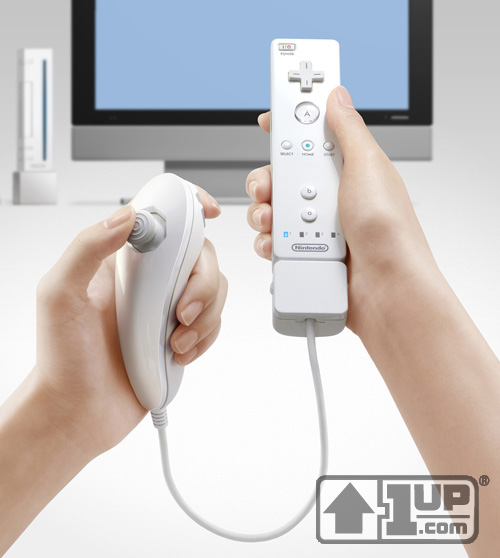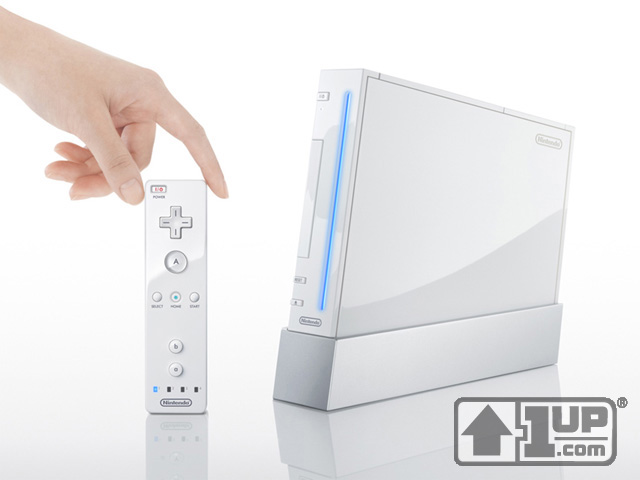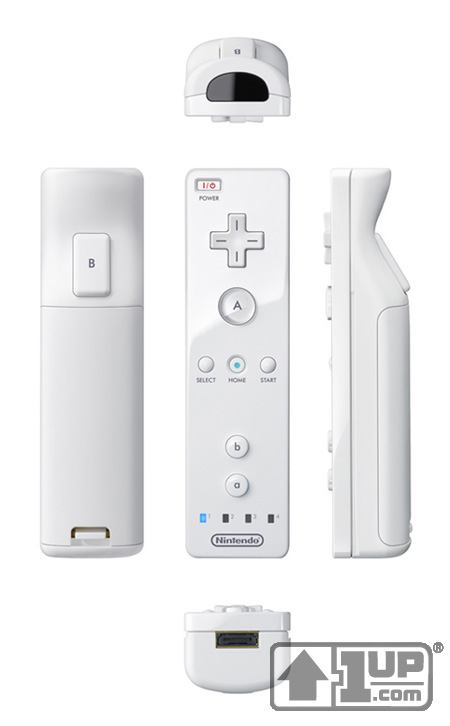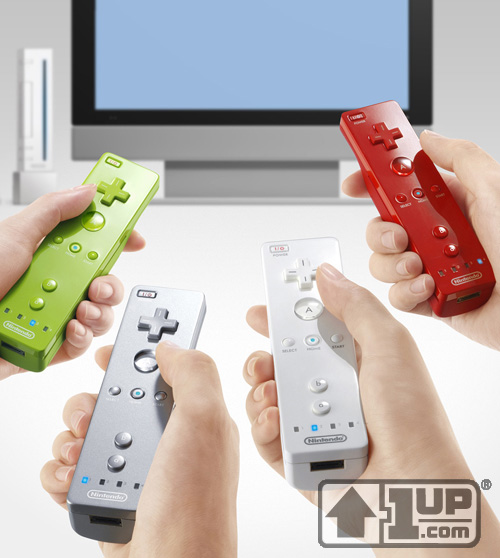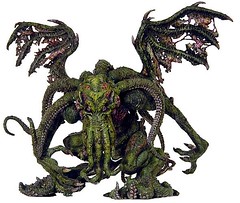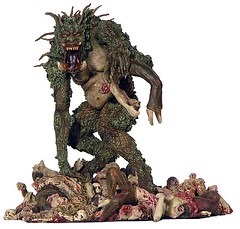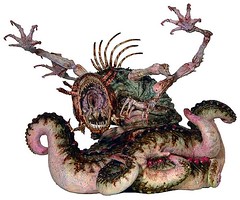Revolution Controller: The Possibilities
We take in an-depth look at Nintendo's next-generation controller and examine how it will work with established videogame genres
The Tokyo Game Show 2005 is an event that won't soon be forgotten by Nintendo fans. The company's president, Satoru Iwata, used his anticipated keynote speech as a forum to publicly unveil the top-secret controller for the Big N's next-generation console, still codenamed Revolution. The device has been the subject of overzealous speculation ever since Nintendo revealed that it would provide the so-called "revolutionary" element to its vision of gaming in the future. And indeed, one look at the peripheral is all it takes to know that the Iwata and company have something very unconventional on their hands, literally. The Revolution's main peripheral, shaped like a stylized remote control, acts like a quasi-virtual wand. Motion sensors packed with the unit are placed atop the player's television screen and the device's every movement is ready and interpreted in the games. The pointer, as we've dubbed it, can influence positioning, targeting, depth and motion in Revolution software. Meanwhile, secondary attachments such as an analog stick can be plugged in for added functionality in tomorrow's hit Nintendo titles.
By now, readers have undoubtedly gleaned all the details about the controller from Iwata's keynote speech and have likewise combed over our hands-on impressions of the device. But even so, it's hard to imagine exactly how the peripheral will function without actually seeing it interact with and direct next-generation games. It is with this thought firmly in mind that we've set out to apply everything we know about the way the controller functions to practical game scenarios and environments. We think readers will be excited by the possibilities.
Action and Platform Games
Popular Examples: The Legend of Zelda: Twilight Princess, Resident Evil 4, Super Mario Bros.
How it might work: The prolific action genre spans such diverse games as Nintendo's own action adventure series The Legend of Zelda, more linear titles like Ubisoft's Prince of Persia, the gunfire heavy Resident Evil 4, or alternative party fun like Super Monkey Ball. While SEGA's monkey games seem tailor-made for tilt control using the pointer, some of the more complex action adventure titles should be trickier -- but the possibilities are exciting nonetheless. There is no doubt that Nintendo's next Mario game will be custom-designed to showcase the controller's special abilities. The left analog stick should allow traditional platforming. We can only dream what the pointer will be used for. Heck, perhaps Luigi's Mansion will make a return as well, allowing players to brand the pointer Ghostbusters-style and wave it in every direction to duplicate the original's trademark "counter-yanking" (yes, that's the technical term for it, look it up).
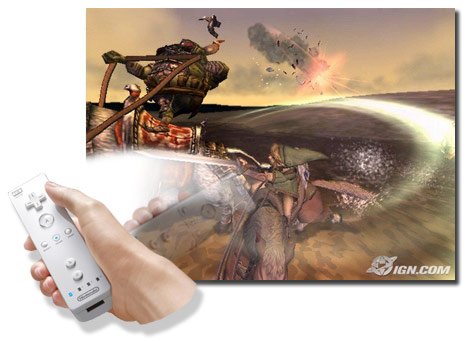
But let's take Prince of Persia and The Legend of Zelda. Players would no doubt navigate the series star with the analog stick unit (or similar) in their left hand, controlling the camera with the pointer. Acrobatics could still be pulled off reasonably well, pressing one of the buttons on the pointer to engage roll or wall-running functions (B) and another to jump (A). If the pointer controls the camera, pressing those buttons could result in inadvertent camera movement -- so there most likely would need to be some sort of camera lock feature that disables the pointer's free-look function. Let's say, players have to tap D-Pad down to engage and disengage this feature, while other D-Pad directions could be assigned to secondary functions (such as picking up weapons). But what of the fighting mechanics? This is where the big changes would come in. Using the left-hand unit's trigger, players could be able to lock on to enemies, which would fix the camera and transform the pointer into a free-form sword controller. Move the controller forward to stab, move it across to slash, slice, and parry -- all the while moving our hero with the left analog stick around his enemies and leaping about using the A button.
But there are definitely some unanswered questions here. Will four face buttons plus D-Pad be enough for all games? Not every developer adheres to Nintendo's simpler is better philosophy and have long been running out of button functions on the GameCube controller, for example. The interesting thing here is that the motion function doesn't just provide camera or directional control -- it effectively replaces the need for multiple attack buttons in a game like Prince of Persia. Things get even more exciting when you consider the multi-weapon and device setups in many action titles. Hookshot or bow and arrow in Zelda? Aim with the pointer, fire with the B button. Magic spells in Harry Potter? Players could trace magic symbols in the air with the wand. Wind Waker, anyone? Lightsabers? Fishing rods? Butterfly nets? Lassos? If Nintendo and other developers develop items and weapons with the unique capabilities of the pointer in mind, gamers should have something special to look forward to.
Adventure Games
Popular Examples: Myst, Shenmue
How it might work: The traditional adventure genre has taken a backseat in recent years to more action-focused titles. While we all fondly remember the days of Maniac Mansion and Sam and Max, one of the few popular entries in the non-action variety of the genre nowadays is Myst. That these types of games haven't lit console gamers on fire isn't really surprising. We all enjoyed what Shenmue was trying to accomplish, but let's face it -- examining stuff can be really boring if the interface is too limited. Cycling through hot spots just isn't fun. Well, here's the chance for the Revolution pointer to shine.
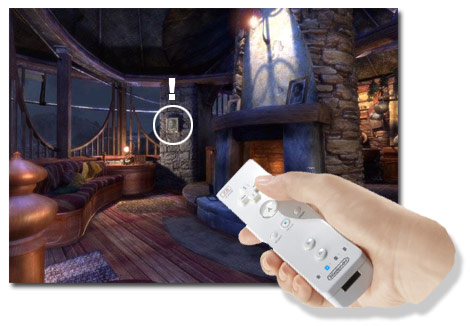
The whole hands-on approach of moving the remote around and grabbing items could help turn mundane tasks into fun ones. Players could examine a room and move around a virtual hand, grabbing items and manipulating objects. If you don't see the attraction here, go grab Wario Ware Twisted and try out some of the interactive toys. There's just something addictive about manipulating objects while the control unit's rumble feedback tricks your brain into feeling texture or resistance. Whether it's examining a dead body on the floor to figure out a mystery, solving 7th Guest-style sliding puzzles or rummaging through an open desk, the pointer may just be able to breathe new life into one of yesterday's most imaginative genres.
Board Games
Popular example: Mario Party 8
How it might work: Franchises like Mario Party are perfectly matched to Nintendo's new controller for a number of reasons. The pointer peripheral is designed so that it can intuitively pick up and move objects in game worlds and there's a lot of that going on in the popular board game series. Clearly, the nunchuck-like analog controller attachment would need to be utilized for many of Mario Party's trademark mini-games. But board operation could be entirely handled with the pointer. In fact, the process could be made more natural than ever before. Gamers could simply point to and pick up dice (with the peripheral's underbelly trigger), roll the pointer in their hand to juggle the dice on screen, and then let go of the trigger to send them flying. A seemingly simple enhancement, sure, but nevertheless the functionality would add an entirely refreshing level of interactivity to the stale genre.
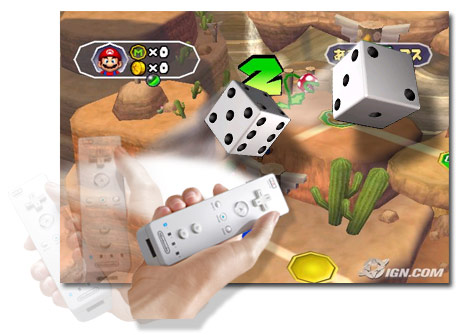
Further, players could point to and pick up cards, manipulate power-ups, and more. When Mario is able to siphon money from a competitor, gamers could actually use the pointer to literally pull money out of their friend's account. On top of everything else, new mini-games could be developed to take advantage of the pointer's sensory functionality. Players might compete in mini-games that revolve around drawing or repositioning tiles, for instance. Mario Party's on-board menu interface could receive a massive overhaul, enabling more dynamic movement and positioning of boxes by way of a highly flexible drag-and-drop system. In a tip of the hat to Apple's OSX Dashboard functionality, gamers could simply tap the trigger button on the pointer to bring all relevant windows to the screen and then using the pointer click on the one with the information or options they're seeking.
Fighting Games Popular examples: Super Smash Bros. Melee, Soul Calibur III
How it might work: Considering we already know that a Revolution version of Super Smash Bros. is currently under development, it goes without saying that the wizards at Nintendo have already given serious thought to the use of the controller in fighting games. Now imagine this: you've used the pointer to lock in your fighter selection, and you're controlling a classic Nintendo character in a vast 3D landscape using the attached analog stick. However, rather than reverting to the skilled-yet-panicked method of finely tuned button mashing, you're now making precision strikes to your opponents to thanks to pre-defined motions with the pointer.
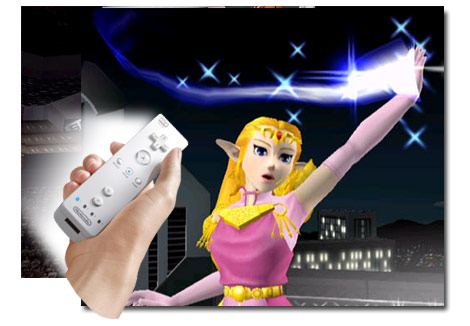
Jab three times quickly to the right for a Kirby flurry of punches. Hold the pointer for two seconds to the right and then slam it left for a charged Smash slice from Link's trusty sword. While it may seem awkward to imagine, the possibilities for attacks are plenty, and each character would have its own predefined range of movements to master. Now toss in the buttons -- A for jumping, and B for grabbing items. The shoulder buttons above the analog stick could easily raise your shields and grapple your enemies. From there, how exactly you choose to punish them depends on the flick of your wrist. Given the physical, frantic, and furious nature of most fighting games, this is one genre that could be very satisfying to control with a little added motion. Just be careful not to get too carried away and smash your brand-new controller in the process.
Racing and Flying Games
Popular examples: Mario Kart, Pilot Wings
How it might work: With the Revolution controller the possibilities for racers and flight simulators are vast and varied, not to mention unique. Purists will no doubt lament the departure from the established analog shoulder button setup, but there is still some interesting potential here. Because the peripheral's connection to on-television motion sensors enables both direction and depth perception, racing and flying scenarios are immediately transformed and simplified.
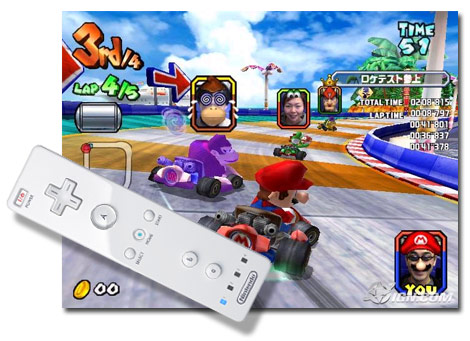
In a future Mario Kart, players could conceivably accelerate by pushing the controller forward and decelerate by pulling it back again. Sharp turns could be made by twisting left or right on the pointer. It might even be possible to turn the pointer on its side and hold it NES style while retaining some depth perception control functionality. Imagine a next-generation Pilot Wings, meanwhile, where the pointer essentially becomes a flight stick, the A button a weapon discharge, and the underbelly B trigger an accelerator. Precise control without a complex configuration exactly as Nintendo intends it.
Roleplaying Games
Popular Examples: Pokemon, Final Fantasy, EarthBound, Paper Mario
How it might work: Nintendo made a concerted effort to bring back the RPGs on GameCube -- after almost missing out on the popular genre entirely on Nintendo 64. While the Revolution controller may seem odd, it shouldn't stand in the way of that trend continuing on the next console. If anything, it may inspire some developers to think outside the established "pick attack from menu" paradigm and do something new. Most RPGs use a tried-and-true system of turn-based or active-time battles. Players encounter enemies, players select attacks and defensive moves, players win and gain experience. Players move on and talk to characters. Some of the control solutions we've outlined under the "adventure" category definitely apply to RPGs as well.
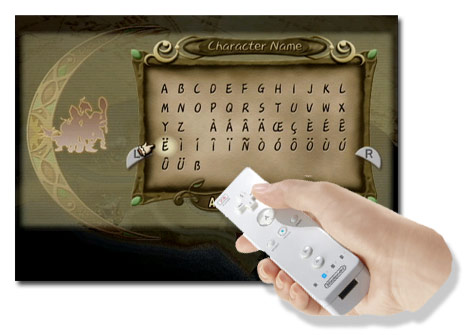
Using the pointer, players would be able to examine things, leaf through books (real page-flipping mechanics, baby!) and spend far less time scrolling through menus and moving cursors to the desired actions and stats points. Card RPGs could benefit from the player's ability to pick and grab cards, magic spells could be performed with wand-like motions, and action-RPGs could get really serious with sword and gun controls that mirror those of their pure-action brethren (perfect for first-person games like Elder Scrolls). Paper Mario has shown that turn-based battles don't have to be a simple click-and-select affair and the same concept could greatly be expanded with the use of the pointer. Whether it's smacking a sabotaging audience member with a quick flick of the wrist or performing various motions to pull off the franchise's imaginative special attacks, the genre that's least dependent on controller innovations may actually see some fresh new ideas because of them.
Shooters
Popular example: Metroid Prime, TimeSplitters
How it might work: Using Nintendo's controller to navigate first-person shooters is going to be an amazingly empowering, freeing experience. We know this because Nintendo demoed a modified version of Metroid Prime 2 Echoes using the new peripheral, and the potential is undeniably jaw-dropping. In the demo, players could move Samus through the environments with the attached analog trigger. The need to lock-on to enemies, however, was been eliminated, thanks to a new level of precision aiming made possible with the pointer. In a level of accuracy rivaled only by a PC mouse configuration, gamers could simply use the device to point and shoot.
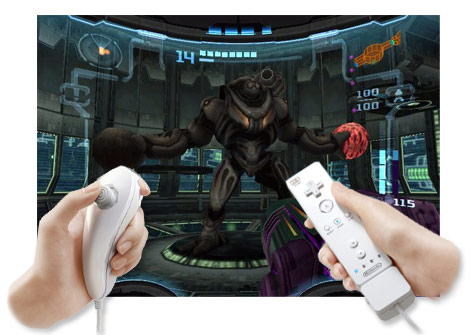
Nintendo fans got a taste of this play mechanic in the demo of Metroid Prime Hunters for DS, but Revolution's pointer is comparatively far more robust, enabling quick and dead-on targeting and the ability to turn on a dime. Developer Retro Studios apparently created the Prime 2 demo in order to test the waters, so to speak, for its upcoming Metroid Prime 3. The studio has a lot of control options at its disposal. Imagine a setup as follows. The attached nunchuck analog stick moves Samus Aran through the game world and the pointer is utilized for precise gunplay. Gamers jump with the oversized A button located beneath the pointer's D-Pad and they shoot with the device's underbelly trigger. Players press up, down, left and right on the conveniently placed D-Pad to switch between visors. Meanwhile, switching weapons will be just as easy. Holding down one of the trigger buttons on the analog stick will transform the D-Pad into a primary weapon select, at which point up, down, left and right on the D-Pad enable different guns. Press down the other button on the analog stick and secondary weapons become available to the D-Pad. Sounds great, right? But how the hell does Samus change into her classic morphball shape and further, how might that be controlled? There are all sorts of possibilities. Gamers could simply make a single downward stabbing motion with the pointer in order to trigger Aran's ball form and then stab upward again to regain her natural composure. When in morphball, Samus could be directed with the pointer with perfect precision. Wow! Bring it.
Sports Games
Popular examples: Madden NFL 2006, NBA Live 2006, Tiger Woods PGA Tour 2006
How it might work: Sports fanatics are largely fanatical about their control. Even this year, as EA made updates in its 2006 Madden offering, one of the largest innovations was new passing controls. So this could be one genre that Nintendo has the most challenges in finding a way for publishers such as EA to bring familiar sports titles to the highly unique Revolution controller.
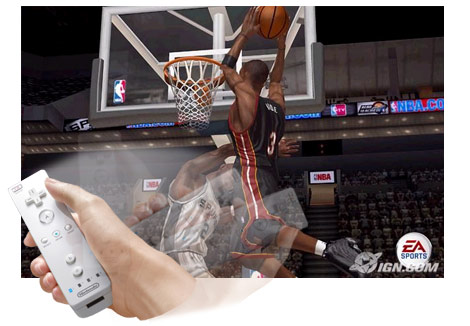
But then again, is it really so tough? Imagine booting up Madden NFL 2007 for Nintendo Revolution and watching your team walk up to the line of scrimmage. You hike the ball with a quick snap of the B trigger, and then you drop your QB into the pocket with the left analog stick. Waving the pointer left and right gives you a quick scan of the downfield receivers on each side of the field. Suddenly you see your man 20-yards down and ready to make his cut to drag across the center of the field. But before you can snap a pass, a linebacker comes crashing through your O line. No problem - hold one of the buttons on your left analog stick to enter scramble mode and break left. Let go and hold the other left button to bring up a passing reticule on-screen. In the blink of an eye, you're able to finely lead your receiver two yards deeper than his route and put the ball just out reach of the cornerback. But rather than hitting a button to pass, simply rear back your pointer and jab it forward at whatever speed you deem necessary to float the pass right into the sweet spot.
Next play -- snap the ball with the B trigger and then watch as your QB hands off to your meaty fullback. While the analog stick could easily function much as previous football sims, now your shucks and jives can be much more intuitive with quick flicks of the pointer. Turbo on the left analog stick buttons, with spins and stiff-arms flowing from A and B. But imagining your quick-steps, jukes, and hurdles coming from quick movements of the pointer seems almost intuitive the more you imagine it. And there's plenty of room for innovation on EA's part here to think outside the box on how a football game has been controlled in the past and how control might become more seamless in the future.
And that's just football. Imagine pitching and batting control in Super Mario Baseball or the precision swing mechanics in Tiger Woods PGA Tour 2006 thanks to the Revolution controller's ability to detect speed and depth motion, and you're looking at entirely new ways to slam a power tee shot, chip a soft nine iron, and put just enough finesse on a short putt to add a new level of skill to the virtual green.
Strategy Games
Popular Examples: Starcraft, Pikmin, Battalion Wars, Fire Emblem
How it might work: While real-time strategy games currently only rule in the PC realm, Nintendo is actually one of the few companies experimenting with more action-focused off-shoots in the console arena. While Fire Emblem and Advance Wars take things slowly and let players think between turns, games like Pikmin and Battalion Wars require both brain and brawn. Nintendo and Kuju came up with some great control solutions to make these games work with the GameCube controller, but orchestrating offensives with multiple groups of characters can be difficult. What's missing is a quick way to select units and send them into battle with pinpoint accuracy. "No, don't attack the flamethrower, you blue idiots! Run! Run!" What's missing is a mouse.
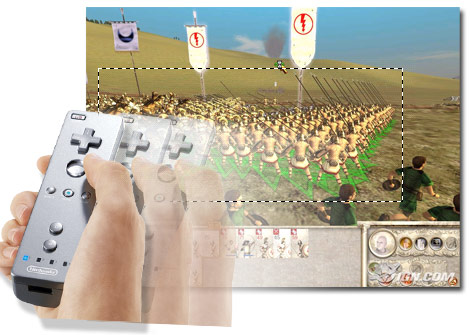
This is where once again Nintendo's pointer concept could shine. In Pikmin, players would be able to walk around with the left analog controller and go about their business as Olimar and friends -- but once squad command comes into play, the right hand could do all the work. Players could pick single Pikmin by pointing at them and pressing a button, select multiple ones by clicking and dragging a selection box around them, and -- most fun of all -- throw them at enemies by flicking the pointer in the right direction while holding down a different button.
Likewise, a console real-time strategy game in the Starcraft mold would greatly benefit from the mouse-like selection and control abilities the pointer provides. A mini-map could allow for quick access of far apart areas, essentially duplicating the exact controls of the PC originals. If the D-Pad doesn't provide enough shortcut key possibilities, the expandable plug-in design of the Revolution controller could even provide for a backlit 10-key unit. And what about turn-based strategy? Again, the pointer's quick-move and pick-and-grab functionality could really be used for great benefit here. Grabbing units and then moving them to the desired place would feel much more natural with the pointing device.
Virtual Characters and Worlds
Popular examples: Nintendogs, Black and White, Spore
How it might work: The Revolution controller's point and click agility makes it the most advanced tool yet for various simulation and "god games." We imagine a wide library of software that makes full use of the device's unique, wand-like input mechanism. A Revolution update to Nintendogs would be an obvious choice and we'd be surprised if one wasn't already in development. Nintendogs for DS offers a greater degree of control than is normally possible thanks to the handheld's touch-screen interface. However, double-tapping the screen to pick up objects is not as intuitive as it could be.
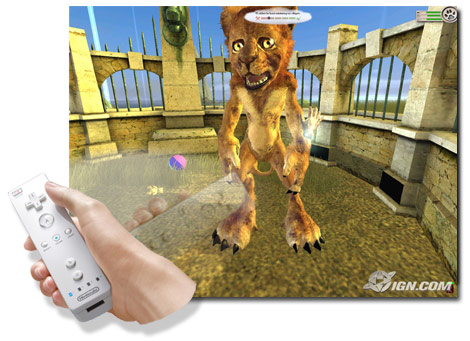
With Revolution, gamers could point to windows in order to select items and objects and simply press the underbelly trigger to pick them up. Meanwhile, washing dogs and combing their fur would be an easy undertaking with the sensory applications of the pointer. Gamers could even use the pointer to, say, pick up a newspaper and (with a downward motion) slap a dog's behind if the animal needs disciplining. In addition, they could pull backward on the pointer in a style similar to reeling in a fish in order to tug a virtual leash and drag forward a disobedient dog.
As intriguing as these possibilities sound, we find ourselves even more excited by the prospects of god games on Revolution. This is true because Nintendo's next-generation controller would enable players the precision and flexibility truly befitting of a creator. Imagine a game similar to Black and White or Spore, in which players can drag and drop materials in order to construct a house, or pick up and position creatures on landscapes with the flick of the wrist. A tap of a button could bring into view a series of palette windows with varying features, each of which would only be a point and click away. Further, gamers could navigate these huge worlds with Nintendo's pointer, holding down a button to go into a travel mode and then moving the wand-like peripheral around to advance through the landscapes. And speaking of landscapes, the pointer could make possible some interesting gameplay mechanics first laid down for Nintendo fans in the little-known GameCube adventure Doshin the Giant. In the quirky title, the giant creature could move about the game world and actually pull pieces of the landscape up in order to raise mountains. With Revolution's pointer, gamers could simply grab onto a landscape and pull backward. This mechanic could be taken a step further. For instance, trees could be planted and then grown in a similar fashion.
Bueno, a los que no sabeis inglés, en que haya un link con todo traducido [hay mucho freak suelto que lo hará], os lo pondré. Solo queda decir algo, que se puede expresar con un dibujo :

Esto ha sido la bomba de los videojuegos quizás desde su invención. Esperemos que acabe el monopolio de los mangantes de sony












